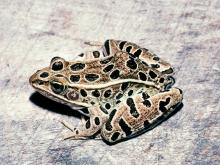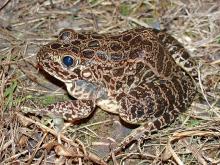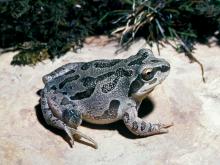Reptiles and Amphibians
Media

Species Types
Scientific Name
Pantherophis ramspotti
Description
The western foxsnake is a moderately large snake with distinct brown blotches. In Missouri, it is rare and found only in our far northwestern counties.
Species Types
Scientific Name
Pantherophis vulpinus
Description
The eastern foxsnake is extremely similar to the western foxsnake and is mainly identified by its different geographic distribution: in Missouri, this rare species is found only in a few counties along the Mississippi River floodplain north from St. Louis.
Media

Species Types
Scientific Name
Nerodia fasciata confluens
Description
The broad-banded watersnake is a semiaquatic snake with broad, irregularly shaped bands that can be brown, reddish brown, or black and are separated by yellow or gray. This nonvenomous species is restricted to the southeastern corner of the state.
Media

Species Types
Scientific Name
Coluber constrictor flaviventris (eastern yellow-bellied racer) and Coluber constrictor priapus (southern black racer)
Description
The eastern yellow-bellied racer is uniformly tan, brown, olive, blue, gray, or nearly black on top, with a yellow, cream, or light blue-gray belly. It occurs nearly statewide. The southern black racer subspecies also lives in the southeastern half of the state.
Media

Species Types
Scientific Name
Lithobates pipiens
Description
The northern leopard frog is a medium-sized frog with dark spots on the back. Two skin folds run down each side of the back. In Missouri, it only occurs in a few northwestern counties along the Iowa border.
Media

Species Types
Scientific Name
Lithobates areolatus circulosus
Description
A very secretive species, the northern crawfish frog spends most of its time hidden burrows, typically those made by crayfish. It is restricted to native prairie or former prairie areas and is a species of conservation concern in Missouri.
Media

Species Types
Scientific Name
Anaxyrus woodhousii woodhousii
Description
The Rocky Mountain toad has a number of irregular dark brown or black spots on the back and a white belly. It occurs in the Missouri River floodplain, mostly from the central to the far northwestern parts of the state.
Media

Species Types
Scientific Name
Pseudacris illinoensis
Description
With its stout body and thick forearms, the rare Illinois chorus frog may at first appear more like a toad. It lives in open, sandy areas that were formerly sand prairie grasslands and wetlands of southeastern Missouri.
Media

Species Types
Scientific Name
Terrapene ornata
Description
The ornate box turtle usually has four hind toes. Its high-domed shell is usually smooth on top, lacks a ridge, and is brown with yellow lines. Look for it in grassy habitats.
Media

Species Types
Scientific Name
Kinosternon flavescens
Description
The yellow mud turtle is a small, uniformly colored, semiaquatic turtle restricted to certain counties in west-central, northeastern, and southwestern Missouri. It is an endangered species in our state.
See Also
About Reptiles and Amphibians in Missouri
Missouri’s herptiles comprise 43 amphibians and 75 reptiles. Amphibians, including salamanders, toads, and frogs, are vertebrate animals that spend at least part of their life cycle in water. They usually have moist skin, lack scales or claws, and are ectothermal (cold-blooded), so they do not produce their own body heat the way birds and mammals do. Reptiles, including turtles, lizards, and snakes, are also vertebrates, and most are ectothermal, but unlike amphibians, reptiles have dry skin with scales, the ones with legs have claws, and they do not have to live part of their lives in water.





















